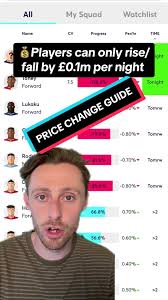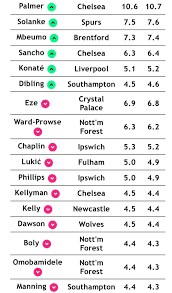Introduction to FPL Price Changes
The Fantasy Premier League (FPL) is gaining attention from football fans globally, with millions participating every season. One crucial aspect that every FPL manager should keep an eye on is price changes, which can significantly affect team composition and overall performance. Understanding these shifts not only helps managers make informed decisions but also enhances their chances of success in this competitive game.
The Mechanics of FPL Price Changes
FPL player prices can fluctuate based on their performance, popularity, and demand among managers. Each player’s price can rise or fall, typically influenced by their on-pitch performances and how many transfers in or out occur. For instance, a player who scores well in a match may attract numerous transfers, leading to an increase in their value. Conversely, a poor performance can lead to an influx of managers selling the player, subsequently lowering their price.
Recent Trends in Player Pricing
As of October 2023, several key players have experienced notable price changes. For example, the emergence of new talents such as Arsenal’s Bukayo Saka and Manchester United’s Alejandro Garnacho has led to significant increases in their prices following impressive performances. Additionally, seasoned players like Mohamed Salah have remained high-value assets due to their consistent scoring ability, even amidst fluctuations due to various performance metrics.
In the current season, managers face the challenge of balancing their budgets while aiming to include high-performing, high-priced players. Data from the FPL official website shows that in the past month, players like Saka saw a price rise of £0.5 million, reflecting their growing popularity. Meanwhile, underperformers such as certain strikers have seen price drops, giving managers the opportunity to reinvest wisely.
Strategies to Manage Price Changes
Effective management of FPL price changes involves staying informed about player performances, monitoring social media reactions, and committing to flexible strategies. Managers often use tools and resources such as price change trackers available on dedicated FPL websites and forums to optimise their transfers.
Importantly, timing remains crucial. FPL managers need to anticipate potential price rises and falls, using wildcards or transfer plans strategically to capitalise on player valuations. Furthermore, recognising when to hold onto certain players or when to make the necessary sacrifices can make a decisive difference in overall points scored throughout the season.
Conclusion: The Significance of Understanding FPL Price Changes
In conclusion, vigilance over FPL price changes is key for any serious fantasy football manager this season. By understanding the dynamics at play and applying strategic planning, managers can not only navigate the challenges posed by fluctuating player prices but also enhance their chances of achieving a strong finish in the league. As the season progresses, staying ahead of these changes could mean the difference between victory and defeat.

